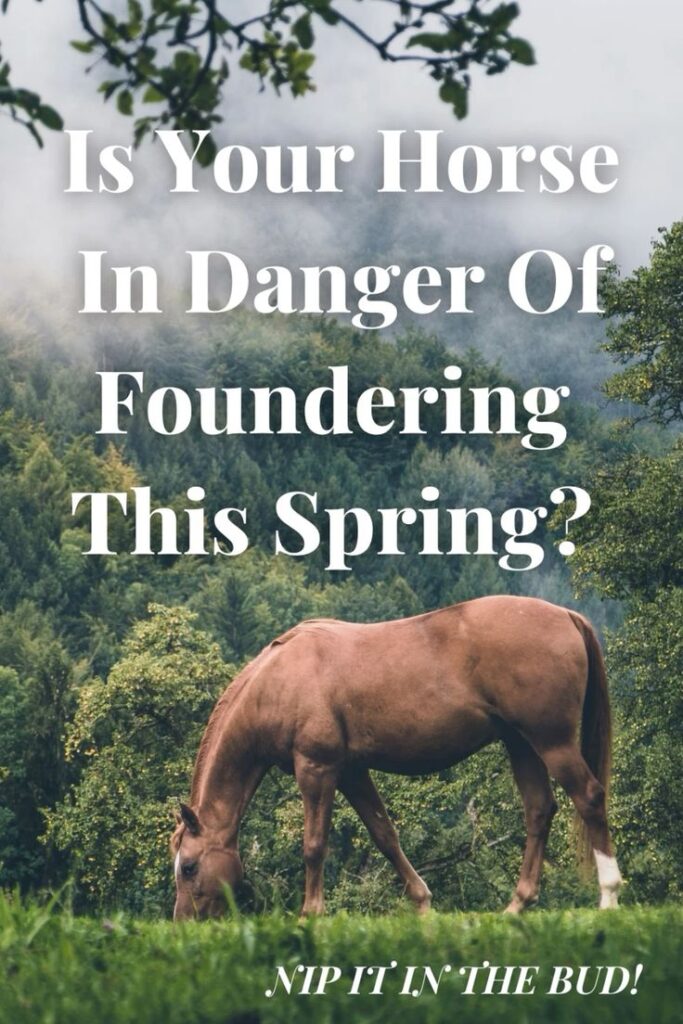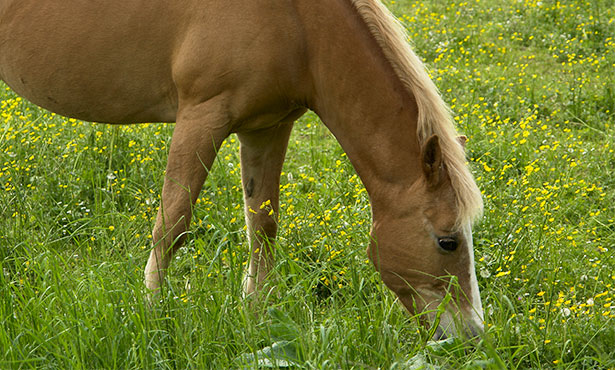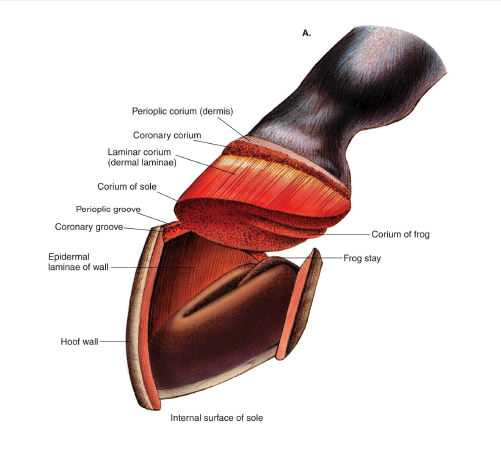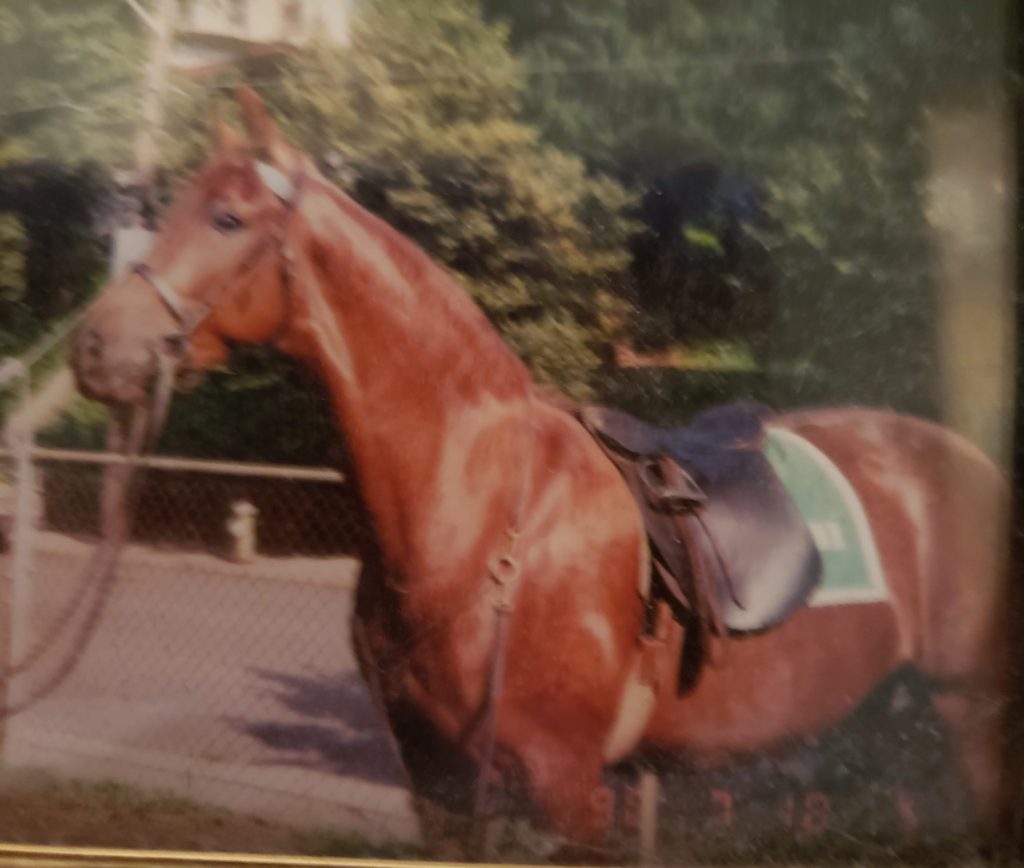Protect Your Horse From Founder

Happy Spring!
It’s finally here! The Daffodils & Forsythia are in bloom! But, be mindful that the beautiful green grass that’s beginning to crop up out in the field may pose a potentially serious problem for your horse…founder!
 Founder…What Is It?
Founder…What Is It?
Founder, or laminitis, is a painful and potentially devastating foot condition that can affect any member of the equine family…horses, ponies, mules and donkeys. There are a number of causes, but probably the most important is over- grazing in lush pasture. It’s thought to be the cause of almost 50% of all cases of laminitis. In most parts of the country, the risk for grass founder is greatest in the spring and early summer, when growth is at it’s peak.
The reason over-grazing on lush grass can cause laminitis is because it is high in soluble carbohydrates—simple sugars such as fructose, and starches, that are easily broken down by the bacteria in the horse’s large intestine. It can lead to a condition very similar to Type II diabetes. It’s called Equine Metabolic Syndrome, or EMS, and it leaves tissues less sensitive to insulin, which causes the pancreas to produce more of this essential hormone.

The result can be damage to the lamina, which is the tissue that attaches the hoof wall to the coffin bone. When compromised, the coffin bone detaches from the hoof wall and may rotate, causing severe founder.
How To Avoid Grass Founder
There are several ways that you can manage the situation:
-
- Put your horse on a dry lot until the grass matures, and feed good quality hay. A dry lot means no grass, not short grass. This is especially important if your horse is over weight or crusty-necked.
- A second strategy is to limit the time your horse is in the pasture. Morning is the best time since the sugar content of the grass is lowest. This has been my method when the horses are at home. Watch out though…horses are very clever. If they figure out that they’ll get only an hour or so to eat they’ll chomp that grass down as fast they can!
- You can use a grazing muzzle. Your horse can be out all day and the muzzle will drastically cut back on the amount of grass he or she can eat. This probably wouldn’t work for me because both Denver and Pirate would probably pull them off, just like they do their blankets! If your horse will cooperate, it’s a great solution. Keep a close watch though, as they can also wear out the muzzle’s bottom, so it’s no longer an impediment to scarfing large quantities of rich sugary grass.
What To Do If Your Horse Founders?
If you think that founder is the problem, take these steps:
-
- First confine your horse to a stall where there is absolutely no grass. Feed only hay. No grain, no alfalfa, no apples or treats of any kind.
- Call your vet and farrier. Trim back any long toes to reduce the pressure. Pack the foot with Styrofoam or other packing material to reduce the stress on the hoof wall. This should help make your horse more comfortable.
- Next you’ll want to reduce the pain with Bute, or Equiiox .
- Ice the feet. Stand the horse in a tub of ice water for at least a half hour at a time, repeating as often as possible. Or, use soaking boots…much more convenient especially if your horse give you a hard time about standing in the tub of ice water.
-
- The farrier will trim the hoof, and put on therapeutic shoes. It is necessary to chop off the toes, and conserve the heel thus reducing the tension on the deep digital flexor tendon. It’s this tendon that attaches to the bottom of the coffin bone and pulls it backward, creating rotation. When lifting the heel, the tension is reduced. The foundered foot needs a lot of help and can take months to resolve, regular farrier care is imperative.
When my horse, Wimsey foundered as the result of an accident, trying to save him was the battle of a lifetime. We tried numerous shoeing techniques, various anti-inflammatory drugs, even nitroglycerin treatments to increase blood flow to the feet. Unfortunately we were unable to save him. There are new products, such as hoof cinches, and protocols , such as acupuncture being used today that may have made all the difference twenty years ago. Let’s hope that research in this area will provide remedies that will save our horses, like my Wimsey, and the great Secretariat.
Have you ever had a horse that foundered? What did you do? How did it work out?


